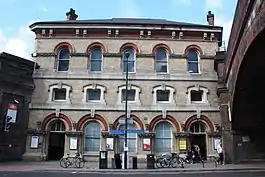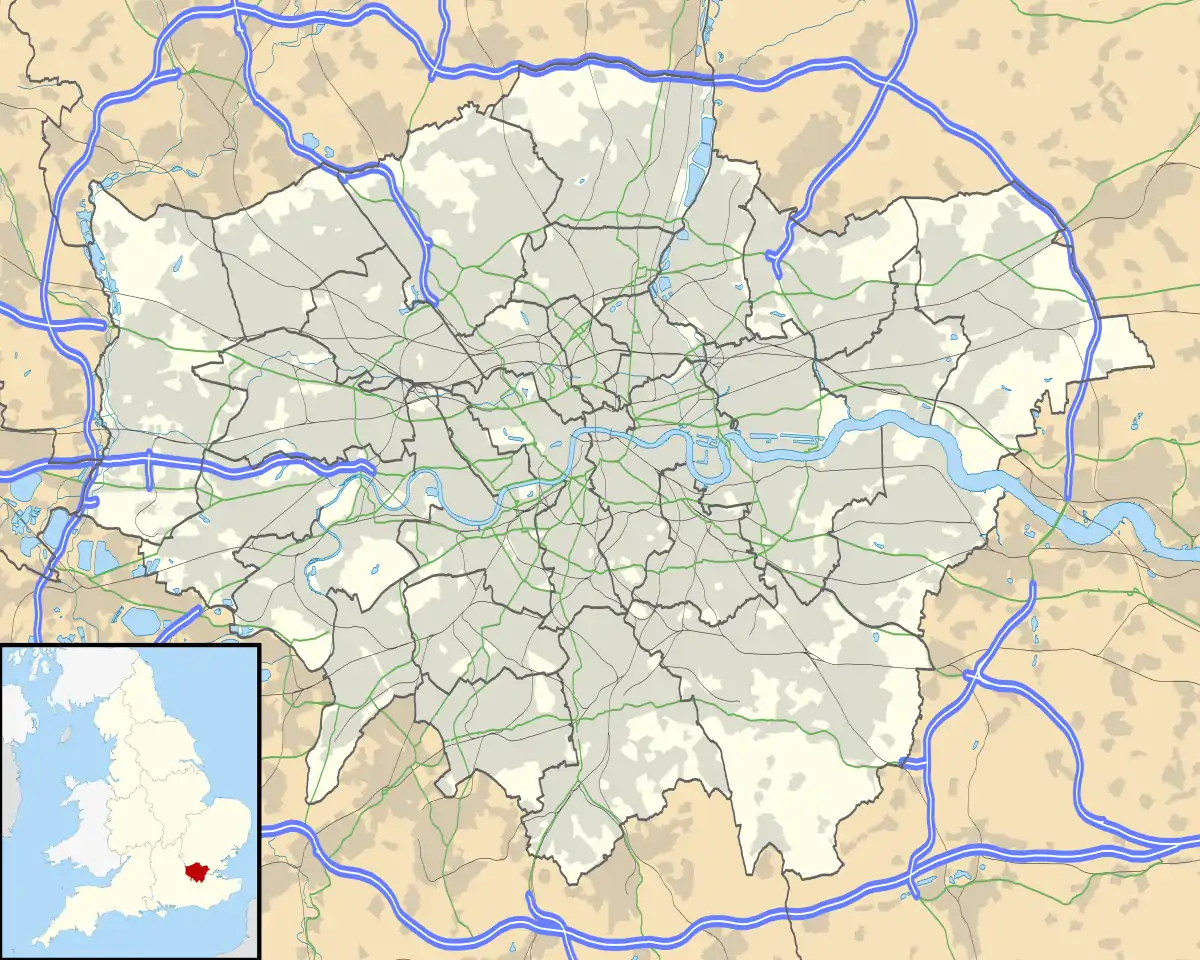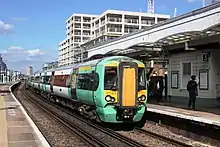Battersea Park railway station
Battersea Park is a suburban railway station in the London Borough of Wandsworth, south London. It is at the junction of the South London Line and the Brighton Main Line (although the physical connection between the lines has been removed), 1 mile 23 chains (2.1 km) measured from London Victoria.
| Battersea Park | |
|---|---|
 | |
 Battersea Park Location of Battersea Park in Greater London | |
| Location | Battersea |
| Local authority | London Borough of Wandsworth |
| Managed by | Southern |
| Station code | BAK |
| DfT category | D |
| Number of platforms | 5 (4 in use) |
| Fare zone | 2 |
| OSI | Queenstown Road (Battersea) |
| National Rail annual entry and exit | |
| 2015–16 | |
| – interchange | |
| 2016–17 | |
| – interchange | |
| 2017–18 | |
| – interchange | |
| 2018–19 | |
| – interchange | |
| 2019–20 | |
| – interchange | |
| Railway companies | |
| Original company | London, Brighton and South Coast Railway |
| Key dates | |
| 1 May 1867 | Opened |
| Other information | |
| External links | |
| WGS84 | 51.4779°N 0.1477°W |
It is close to Battersea Park, and not far from Battersea Power Station. It is also a short walking distance from Queenstown Road (Battersea) station.
In the future, it will have an out of station interchange (OSI) with the future Battersea Power Station tube station on the under construction Northern line extension, part of the London Underground.
Description
The station has a polychrome brick Venetian Gothic facade. It is a Grade 2 listed building designed by Charles Henry Driver.
Access to the five platforms is via steep wooden staircases, which are unusable by infirm or physically disabled passengers. Most services at the station call at Platforms 3 and 4, on the slow lines into Victoria. Platform 1 (the former down South London line platform) is made completely from wood and ceased to be used from December 2012. Platform 1 has had its tracks removed and its future is uncertain. Platform 2 (the former up South London line platform) is used by the limited London Overground services that serve the station; it is now a terminal platform since the adjacent Platform 3 was extended over the former junction between the South London and main lines in 2014. Platform 5, on the down fast line from Victoria, is rarely used, usually during engineering works or congestion problems in London Victoria with services passing towards Clapham Junction.
The station will be within short walking distance of Battersea Power Station Underground station, an extension of the Northern line to Battersea Power Station expected to open in 2021. The two stations will serve as an out of station interchange.[2]
History

The first station to carry the name "Battersea Park" was opened by the London, Brighton and South Coast Railway (LB&SCR) as "Battersea" on 1 October 1860 and was located at the southern end of what is now Grosvenor Bridge. It was named "Battersea Park" on 1 July 1862 but was sometimes called "Battersea Park and Steamboat Pier". It closed on 1 November 1870 concurrently with the opening of Grosvenor Road station situated at the north end of Grosvenor Bridge.[3][4] The LB&SCR opened a high-level line between Pouparts Junction and Battersea Pier Junction on 1 May 1867 as a means of reducing congestion at Stewarts Lane. York Road (Battersea) station opened at this time.[5] The station was renamed Battersea Park and York Road 1 January 1877 and Battersea Park on 1 June 1885.[6]
The South London line through the station to London Bridge was electrified on 1 December 1909 'Elevated Electric' overhead system.[7][8] and to Crystal Palace on 12 May 1911, on the LB&SCR 'Elevated Electric' overhead system.[9][8]
At the end of August 2009, electronic ticket gates were installed. There was some staffing provision but the station has been fully staffed from first to last train as part of the Southern franchise from September 2009.
With the redevelopment of Battersea Power Station into "The Power Station London", the station is due a complete refurbishment.[10]
Services
Services are operated by Southern and London Overground. Queenstown Road (Battersea) is around the corner, within easy walking distance and provides access to South West Trains services, though transfer at Clapham Junction is more common.
The typical off peak service is:[11]
- 10 trains per hour (tph) to London Victoria
- 4 tph to Sutton
- two continuing to Epsom Downs
- 2 tph to Caterham
- 2 tph to London Bridge (via Crystal Palace)
Until December 2012, Southern operated a twice-hourly service from London Victoria to London Bridge via Denmark Hill. This ceased when London Overground's Clapham Junction to Dalston Junction service commenced at that time. However, since December 2012, a skeleton London Overground service has run to and from Battersea Park (instead of Clapham Junction) at the extreme ends of the day to retain a "parliamentary service" between Battersea Park and Wandsworth Road.[12] The station is also used by London Overground when the route into Clapham Junction is closed by engineering work.
On Mondays to Fridays, the London Overground service departs for Dalston Junction at 06:33 and 23:03. A service returns from Dalston Junction at 22:04. On Sundays, there is a service to Highbury & Islington at 07:26 with no return journey.
Due to the very limited London Overground service, Battersea Park does not appear on the standard Tube and Overground maps, although it does appear on line diagrams inside Overground trains.[13]
| Preceding station | Following station | |||
|---|---|---|---|---|
| London Victoria | Southern Brighton Main Line |
Clapham Junction | ||
towards Dalston Junction | South London Line Very limited Service | Terminus | ||
Accidents
1881 crash
On 24 December 1881, a train hauled by LBSC Terrier No.70 Poplar collided with the rear of the 11:35pm from London Bridge due to a fogman's error.[14]
Battersea Park rail crash (1937)
On 2 April 1937, two electric passenger trains collided just south of the station; ten people were killed and 17 seriously injured. The signalman at Battersea Park, believing there to be a fault with his equipment, overrode the electrical interlocking and allowed the second train into the occupied section.[15]
Battersea Park Station rail crash (1985)
On 31 May 1985, 1D91 09:20 Gatwick Airport to Victoria Gatwick express formed of Class 489 GLV, Class 488 8301, 8203, 8313, Class 73 73117 collided with 2L51 08:51 East Grinstead to Victoria formed of DEMU Class 205 1113 and Class 207 1309 travelling along the up fast main line from Clapham Junction. Train 1D91 was following 2L51 along the Up Fast line, through Clapham Junction station, at which the latter train had made a scheduled stop and beyond towards Battersea Park. 1D91 had closed sufficiently on 2L51 that the former passed a series of signals displaying a 'single yellow' caution aspect, at which the driver cancelled the AWS warning and continued, as he was entitled to, at a speed of around 30 mph (48 km/h). Train 2L51 was then stopped for 1–2 minutes at signal VC552 displaying a red aspect. When that signal cleared, 2L51 was accelerating past it when it was struck from behind by 1D91 which had passed the protecting signal, VC564, at Danger.[16]
A consensus of evidence suggests that at the moment of collision 2L51 had reached a speed of between 5 and 10 mph (8–16 km/h), whilst 1D91 was still travelling at between 25 and 30 mph (40–48 km/h), so that the net collision speed was about 20 mph (32 km/h). After the collision the trains separated and came to rest 20 m (66 ft) apart. There was no derailment but the shock of collision passing down each train caused damage throughout the length of both. Only one vehicle sustained severe structural damage; this was the leading passenger coach of 1D91, running immediately behind the GLV. This coach sustained a small degree of telescoping at underframe level, and hinging down of its trailing end, so that the saloon floor buckled upwards by about 600 mm (24 in) with consequent displacement of seats in one bay. One window each side was broken when this deformation occurred through the window opening, but the general integrity of the vehicles could be judged by the fact that these were the only external windows broken throughout the two trains.[16]
The trains were conveying a large number of passengers, one estimate being as high as 800. In the collision 104 persons suffered injury and were taken to two hospitals by means of ten ambulances, the first of which arrived at 09:58. Most of the injured suffered only cuts and bruises and were discharged after treatment, but eighteen had serious injuries requiring detention in hospital for periods between one and fourteen nights. Twenty other passengers later reported having suffered injury. The uninjured passengers were conveyed forward to Victoria at 10:58 by a special train, the unobstructed Slow lines having been re-energised for electric trains at 10:45 after an initial complete isolation of the conductor rails in the area. During the day the damaged trains were made fit to move and hauled into sidings so that, there being no damage to the track or signalling equipment, normal working was resumed at 16:12.[16]
Motive Power Depots
The West End of London and Crystal Palace Railway opened an engine shed off what is now Prince of Wales Drive on 29 March 1858. It closed in 1877.[17]
The London Brighton and South Coast Railway built a roundhouse a few yards north of the station on the lower level in 1869, extended with a second adjoining roundhouse in 1870 and a third in 1889. It closed 15 July 1934, but remained in use as a road transport depot until demolished in 1986.[18]
Connections
London Buses routes 44, 137, 156, 344, 436 and 452 and night routes N44 and N137 serve the station.
References
- "Station usage estimates". Rail statistics. Office of Rail Regulation. Please note: Some methodology may vary year on year.
- "Northern Line Extension". Transport for London. Retrieved 13 November 2014.
- London's Disused Stations Volume 6 by J.E.Connor
- Chronology of Londons Railways by H.V.Borley
- Turner, John Howard (1978). The London Brighton and South Coast Railway 2 Establishment and Growth. Batsford. p. 199. ISBN 0-7134-1198-8.
- Turner, John Howard (1978). The London Brighton and South Coast Railway 3 Completion and Maturity. Batsford. p. 99. ISBN 0-7134-1389-1.
- Moodie, G.T. (1968). Southern Electric 1909–1968=Ian Allan. p. 3.
- Southern Region Record by R.H.Clark
- Moodie, G.T. (1968). Southern Electric 1909–1968=Ian Allan. p. 4.
- "Costain wins Battersea Park station deal" Archived 18 January 2016 at the Wayback Machine, Contract Journal, April 2006
- GB eNRT May 2016 Edition, Tables 170 & 180/181
- "Highbury and Islington to West Croydon and Clapham Junction Timetable" (PDF). London Overground. Archived from the original (PDF) on 11 November 2016. Retrieved 15 November 2016.
- Middlemass, Tom (1995). Stroudley and his Terriers. York: Pendragon. p. 44. ISBN 1-899816-00-3.
- Mount, Lt Col A H L (18 May 1937). "Report on the Accident at Battersea Park" (PDF). Ministry of Transport. Retrieved 2 September 2008.
- Mount, Lt Col A H L (31 May 1985). "Report on the Accident at Battersea Park" (PDF). Department of Transport. Retrieved 2 September 2008.
- Griffiths, Roger (1999). Directory of British Engine Sheds: 1. Oxford Publishing. p. 87. ISBN 0-86093-542-6.
- Griffiths, (1999), p.87.
External links
| Wikimedia Commons has media related to Battersea Park railway station. |
- Train times and station information for Battersea Park railway station from National Rail
